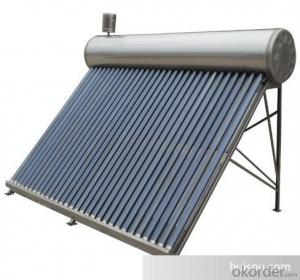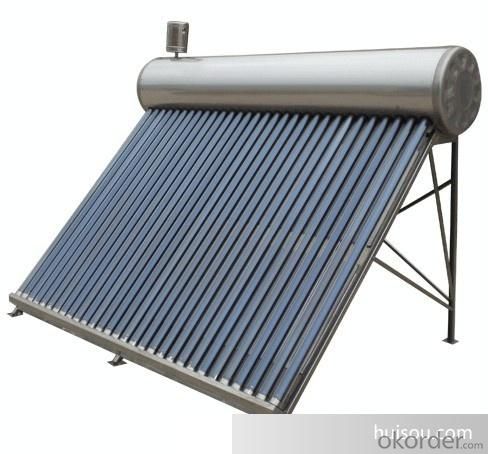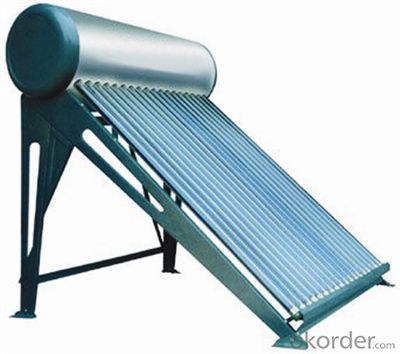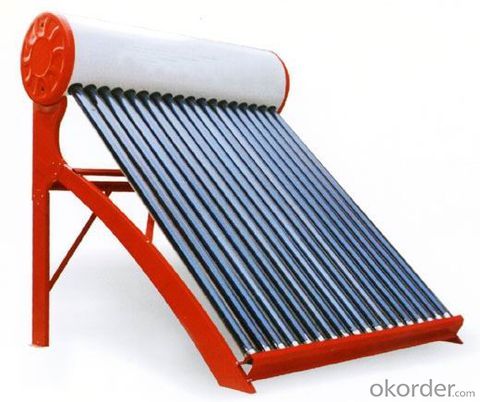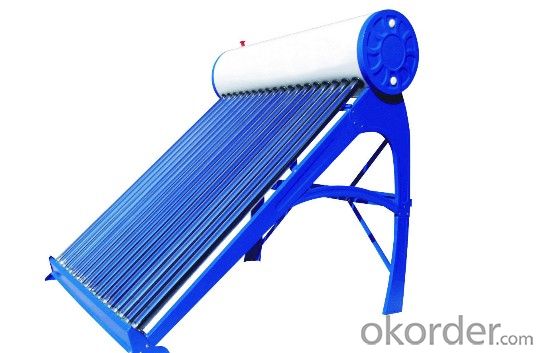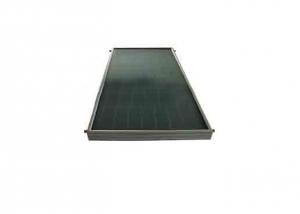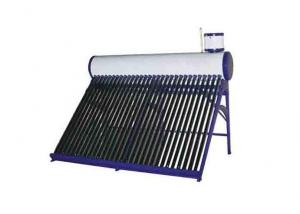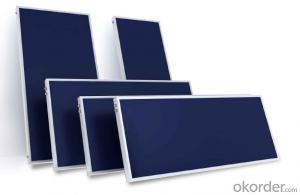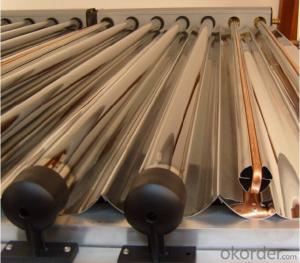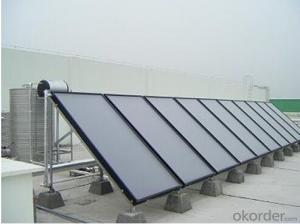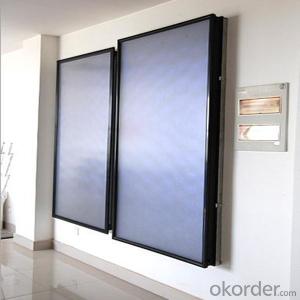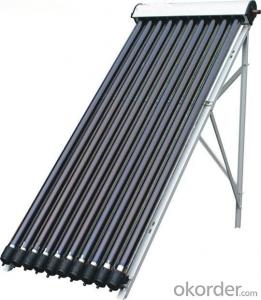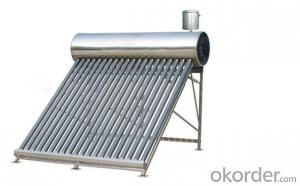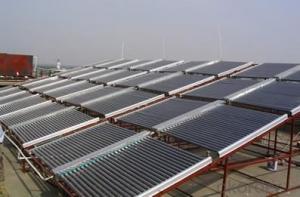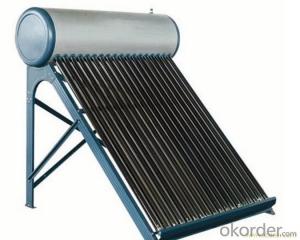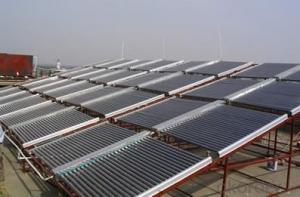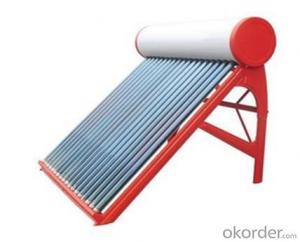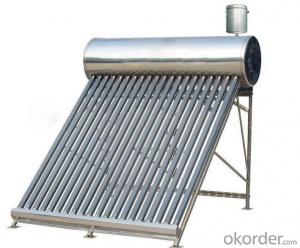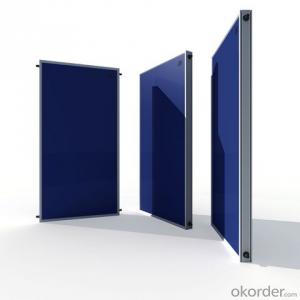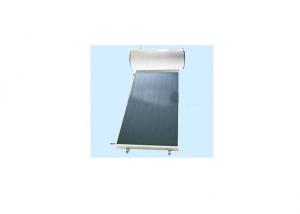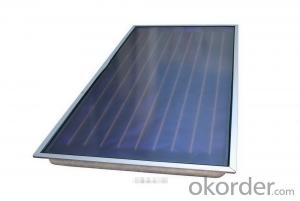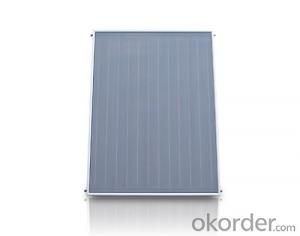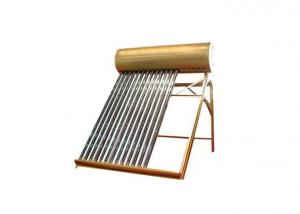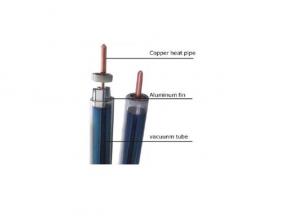1 2 Sphere Solar Collectors Heat Pipe Copper Solar Water Heater System 2024 New Design
- Loading Port:
- China main port
- Payment Terms:
- TT OR LC
- Min Order Qty:
- 1 set
- Supply Capability:
- 6000 set/month
OKorder Service Pledge
OKorder Financial Service
You Might Also Like
Introduction of Non-Pressure Solar Water Heater:
Non-pressure Solar Heater is one of the most economical solar water heating device with pretty high efficiency at the same time. It consists of hot water storage tank, solar vacuum tubes with mouth plug in storage tank, and bracket supporting tank and tubes.When cold water in evacuated tubes is heated with solar irradiation, as the specific gravities of hot water and cold water are different, hotter water goes upward to storage tank and colder water goes downward to glass tubes. through this continuous circulation, the cold water in storage tank will be gradually heated till sunset.
Specialty:
1. High thermal performance and working temperature: the heat exchanging rate even in winter can up above 55%.
2. Heat collecting efficiency is at least 20% above common solar systems.
3. Work in all day and all season: no matter any corner of the world, this system can work well even -40℃ to avoid the tube freezing problem.
4. Reliability: No water following through the tube, so water scale can not generate and tube cracks could be avoided, the system still can keep working even with some damaged tubes.
5. It can connect with water tap and work automatically with pressure0.6Mpa, bring enjoyable washing experience.
6. Safety: P/T valve would release pressure and temperature to protect tank..
Technical Specification:
1. Outer tank material: SUS304 stainless steel or powder coated color steel
2. Inner tank material: 1.2mm thick SUS304 food grade stainless steel ( Optional material SUS316L)
3. Vacuum tube material: borosilicate glass 3.3; AL-SS-CU absorb coating, with copper heat pipe inside
4. Frame material: 1.2mm thickness stainless steel
5. Insulation material: 55mm thickness polyurethane
6. Suitable for mains pressure water(up to 8 bar/116psi)
7. Easy plug-in installation
8. Install the T/P valve on the pressurized tank
9. Seal material: Stabilized High Temperature Silicon
Outer tank material: SUS304 stainless steel or powder coated color steel
Inner tank material: 1.2mm thick SUS304 food grade stainless steel ( Optional material SUS316L)
Vacuum tube material: borosilicate glass 3.3; AL-SS-CU absorb coating, with copper heat pipe inside
Frame material: 1.2mm thickness stainless steel
Insulation material: 55mm thickness polyurethane
Suitable for mains pressure water(up to 8 bar/116psi)
Easy plug-in installation
Install the T/P valve on the pressurized tank
Seal material: Stabilized High Temperature Silicon
19. Vacuum Tube | 20. Size (mm) | 21. Φ47*1500 / Φ58*1800 / Φ70*2100 | |||||
22. Tube (pcs) | 23. 10 / 12 / 15 / 18 / 20 / 22 / 24 / 30 / 36 / 42 | ||||||
24. Material | 25. Borosilicate 3.3 glass, magnetron spluttering selective coating | ||||||
26. Coating | 27. Single-target AL-N/AL or Three-target AL/N-Cu-SS | ||||||
28. Water Tank | 29. Capacity | 30. 80L ~ 500L for hot water storage tank | |||||
31. Inner tank | 32. Food-grade stainless steel SUS304-2B / SUS316 | ||||||
33. Insulation | 34. High-density polyurethane foam with 70~80 hour heat preservation | ||||||
35. Tank shell | 36. Food-grade stainless steel SUS304-2B | ||||||
37. Bracket | 38. Shaped strong aluminum alloy structure adaptable for flat or slope roof | ||||||
39. Accessories | 40. Anti-aging silicon seals, Dustproof seals, Air-vent cap, Stainless screws | ||||||
41. Auxiliary Devices | 42. Assistant tank, Intelligent controller, Electrical heater, Magnesium anodes | ||||||
43. Tilt Angle | 44. 25 ~ 50° | ||||||
45. Water Output | 46. 45 - 95°C | ||||||
47. Hail Resistance | 48. Φ25mm diameter | ||||||
49. Model Number | 50. Solar Vacuum Tube | 51. Tank 52. Liter | 53. System 54. Liter | 55. Container Loading Qty /sets | |||
56. Size /mm | 57. Qty /pcs | 58. 20GP | 59. 40GP | 60. 40HQ | |||
61. VNS-58SA12-100 | 62. Φ58*1800 | 63. 12 | 64. 100 | 65. 132 | 66. 58 | 67. 119 | 68. 140 |
69. VNS-58SA15-130 | 70. 15 | 71. 130 | 72. 170 | 73. 54 | 74. 108 | 75. 131 | |
76. VNS-58SA18-150 | 77. 18 | 78. 150 | 79. 198 | 80. 43 | 81. 86 | 82. 105 | |
83. VNS-58SA20-170 | 84. 20 | 85. 170 | 86. 223 | 87. 40 | 88. 80 | 89. 97 | |
VNS-58SA24-200 | 24 | 200 | 263 | 35 | 70 | 85 | |
VNS-58SA30-250 | 30 | 250 | 329 | 28 | 56 | 68 | |
VNS-58SA36-300 | 36 | 300 | 395 | 23 | 47 | 57 | |
Product Show
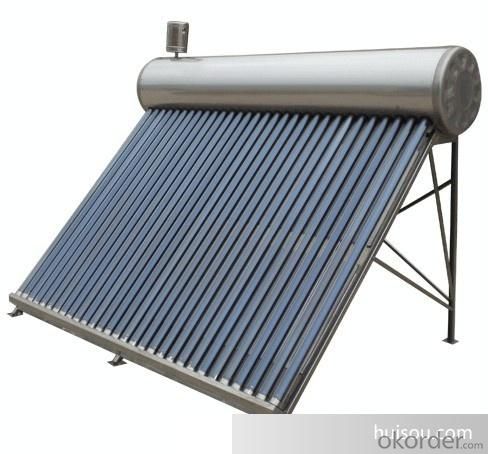
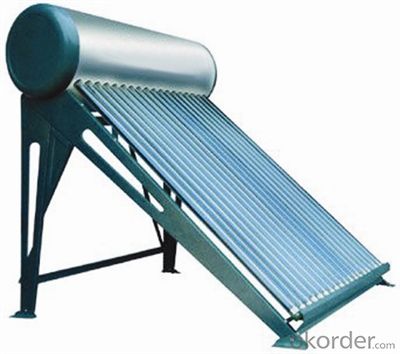
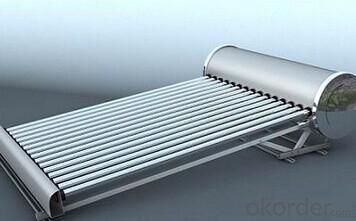
Our Services
1. OEM service
2. Warranty: 5 years
3. Considerable after sale service
Color steel Compact pressure Thermal solar heater
FAQ:
1. What’s the delivery time?
10 days after receiving deposit.
2. How long is the warranty?
5 years for whole system, 1 year for accessory
3. What’s your production capacity?
6000sets/month
4. What’s the MOQ?
1 set.
5. What’s your payment term?
Container: 30% T/T in advance for deposit, 70% T/T before shipment for fist order.
70% T/T after seeing copy of B/L from second order
Sample: 100% T/T in advance
Other choices: L/C at sight.
6. What certifications do you have?
CE, SOLAR KEYMARK, SRCC and etc.
- Q: Can solar collectors be used for heating amusement parks?
- Yes, solar collectors can be used for heating amusement parks. Solar thermal systems can provide a sustainable and cost-effective solution for heating water used in various facilities within amusement parks, such as swimming pools, shower areas, and food service areas. By harnessing the power of the sun, solar collectors can help reduce operational costs and environmental impact, making it an attractive option for heating in amusement parks.
- Q: Can solar collectors be used for generating electricity on warehouses?
- Yes, solar collectors can be used for generating electricity on warehouses. Solar collectors, also known as solar panels, can be installed on the rooftop of warehouses to harness sunlight and convert it into electricity. These panels are made up of photovoltaic cells that absorb sunlight and generate direct current (DC) electricity. This DC electricity is then converted into alternating current (AC) electricity through an inverter, which can be used to power the electrical systems within the warehouse or even feed excess electricity back into the grid. Solar collectors are a sustainable and environmentally-friendly way of generating electricity, as they rely on renewable energy sources and produce zero greenhouse gas emissions. Additionally, installing solar collectors on warehouses can help businesses reduce their dependence on fossil fuels, lower their electricity bills, and contribute to a cleaner energy future.
- Q: Can solar collectors be used for heating barns?
- Yes, solar collectors can be used for heating barns. Solar collectors, such as solar water heaters or air heaters, can capture and convert sunlight into heat energy, which can then be used to warm the air or water in barns. This can provide a cost-effective and sustainable alternative to traditional heating methods for barns.
- Q: Can solar collectors be used in mining operations?
- Yes, solar collectors can be used in mining operations. They can be used to provide renewable energy for various mining processes, such as powering machinery, lighting, and ventilation systems. Solar collectors can help reduce reliance on fossil fuels, lower operational costs, and minimize environmental impact in mining operations.
- Q: Can solar collectors be used in combination with solar tracking systems?
- Yes, solar collectors can be used in combination with solar tracking systems. Solar collectors are designed to capture and convert sunlight into usable energy, while solar tracking systems are used to maximize the amount of sunlight received by adjusting the position of the solar panels or collectors throughout the day. By combining these two technologies, the efficiency and output of a solar energy system can be significantly increased. Solar tracking systems work by following the movement of the sun and adjusting the angle and orientation of the solar collectors accordingly. This allows the collectors to capture sunlight at its optimal angle, maximizing the amount of energy that can be generated. The ability to track the sun throughout the day ensures that the solar collectors are always positioned to receive the maximum amount of sunlight available. In combination with solar tracking systems, solar collectors can enhance the overall performance of a solar energy system. They can be used in various applications, such as solar thermal collectors for heating water or air, or photovoltaic (PV) panels for generating electricity. By utilizing both solar collectors and solar tracking systems, the energy output can be increased, making the system more efficient and cost-effective. However, it is important to note that the implementation of solar tracking systems may come with additional costs and maintenance requirements. The moving parts and mechanisms involved in tracking the sun's movement need to be carefully maintained to ensure proper functioning. Additionally, the increased efficiency offered by solar tracking systems may not always justify the additional investment, especially in regions with high solar irradiance throughout the year. In conclusion, solar collectors can indeed be used in combination with solar tracking systems to maximize the efficiency and energy output of a solar energy system. However, the decision to incorporate solar tracking should be carefully evaluated based on the specific needs, location, and cost-effectiveness of the project.
- Q: Can solar collectors be used for heating car washes and automotive service centers?
- Yes, solar collectors can be used for heating car washes and automotive service centers. Solar collectors can harness solar energy to heat water or air, which can then be used for various heating purposes in car washes and automotive service centers. This can provide a cost-effective and environmentally friendly alternative to traditional heating systems.
- Q: Can solar collectors be used for greenhouse heating?
- Yes, solar collectors can be used for greenhouse heating. Solar collectors, such as solar thermal panels, can absorb sunlight and convert it into heat energy, which can then be used to warm up the greenhouse. This sustainable heating method can help maintain optimal temperatures for plant growth and reduce reliance on traditional heating systems.
- Q: Can solar collectors be used for heating commercial buildings?
- Yes, solar collectors can be used for heating commercial buildings. Solar thermal systems can be installed on rooftops or open areas to collect solar energy and convert it into heat. This heat can then be used to provide hot water or space heating for commercial buildings, reducing the reliance on traditional heating systems and reducing energy costs.
- Q: How does the orientation of a solar collector affect its performance?
- The orientation of a solar collector significantly affects its performance. The collector should be properly oriented to maximize solar energy absorption. Ideally, the collector should be facing towards the sun, with a tilt angle that corresponds to the latitude of the location. By optimizing the orientation, the collector can capture the maximum amount of solar radiation, thereby enhancing its efficiency and overall performance.
- Q: Can solar collectors be used in remote areas without electricity?
- Without access to electricity, remote areas can utilize solar collectors to harness the ample solar energy present in these regions. These devices, also known as solar panels or photovoltaic (PV) systems, are designed to convert sunlight into electricity. They do not necessitate a direct connection to an electrical grid or power supply, making them perfect for areas where electricity infrastructure may be absent or unreliable. In these remote regions, solar collectors can be installed to capture the abundant solar energy available. The panels absorb sunlight and transform it into electrical energy, which can be used for various purposes such as powering lights, appliances, and even charging batteries. This offers a sustainable and eco-friendly solution to meet the energy requirements of the remote communities. Solar collectors are particularly advantageous in remote areas due to their low maintenance needs and long lifespan. Once installed, the panels require minimal upkeep, reducing the necessity for regular maintenance visits. Additionally, solar collectors are durable and have an average lifespan of 25-30 years, making them a dependable and long-term energy solution for remote areas. Furthermore, the implementation of solar collectors in remote areas can reduce reliance on fossil fuels, decrease greenhouse gas emissions, and contribute to climate change mitigation efforts. By substituting traditional energy sources like diesel generators or kerosene lamps with solar power, remote communities can lower their carbon footprint and enhance overall environmental conditions. Although initial installation costs may present challenges in some cases, the long-term benefits of utilizing solar collectors in remote areas without electricity far outweigh the disadvantages. Governments, non-profit organizations, and international agencies have acknowledged the importance of renewable energy in remote areas and have implemented various programs and initiatives to support the adoption of solar collectors in these regions. In conclusion, solar collectors can certainly be employed in remote areas without electricity. They offer a reliable and sustainable energy source, reduce dependence on fossil fuels, contribute to environmental preservation, and enhance the overall living standards of remote communities.
Send your message to us
1 2 Sphere Solar Collectors Heat Pipe Copper Solar Water Heater System 2024 New Design
- Loading Port:
- China main port
- Payment Terms:
- TT OR LC
- Min Order Qty:
- 1 set
- Supply Capability:
- 6000 set/month
OKorder Service Pledge
OKorder Financial Service
Similar products
Hot products
Hot Searches
Related keywords
